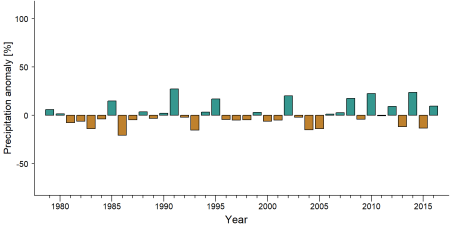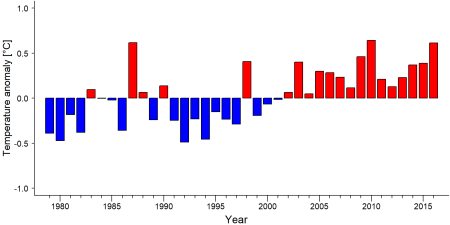Test
West Africa > Nigeria > Ala Forest Reserve
Français | Português | Español | Bahasa Indonesia | Melayu
Summary
- Nigeria-Cameroon chimpanzees (Pan troglodytes ellioti) have been present in Ala Forest Reserve.
- Chimpanzees are extinct or nearly extinct at the site.
- The chimpanzee population trend is unknown.
- The site has a total size of 199 km².
- Key threats to chimpanzees are hunting and logging for oil palm, cocoa, and teak plantations.
- Conservation activities not documented.
Site characteristics
Table 1. Basic site information for Ala Forest Reserve
| Species | |
| Area | 199 km² |
| Coordinates | 7.051510, 5.436220 |
| Type of site | Forest Reserve |
| Habitat types | Arable land, plantations, subtropical/tropical heavily degraded forest, subtropical/tropical moist lowland forest |
| Type of governance |
IUCN habitat categories Site designations
Ape status
Chimpanzees are extinct or nearly extinct in Ala Forest Reserve. During a 2006 survey, no chimpanzees, nor signs of chimpanzees, were encountered (Greengrass 2006).
Threats
The northern half of the reserve is dominated by teak, oil palm, and cocoa plantations (Greengrass 2006). In the southern half of the reserve, even though the forest seems to be in a better condition, logging pressure is very high and large mammals are very scarce (Greengrass 2006).
Table 3. Threats to apes in Ala Forest Reserve
| Category | Specific threats | Threat level | Description | Year of threat |
|---|---|---|---|---|
| 1 Residential & commercial development | Unknown | |||
| 2 Agriculture & aquaculture | 2.1 Annual & perennial non-timber crops | High | Oil palm and cocoa plantations in the northern half of the reserve (Greengrass 2006) | Ongoing (2006) |
| 2.2 Wood & pulp plantations | High | Land cleared for teak plantations (Greengrass 2006) | Ongoing (2006) | |
| 3 Energy production & mining | Unknown | |||
| 4 Transportation & service corridors | 4.1 Roads & railroads | High | A road crosses the reserve from north to south (Greengrass 2006) | Ongoing (2006) |
| 5 Biological resource use | 5.1 Hunting & collecting terrestrial animals | High | Hunter trails and a large number of discarded cartridges were found in the southern part of the reserve, where chimpanzees were last seen (Greengrass 2006) | Ongoing (2006) |
| 5.3 Logging & wood harvesting | High | Logging pressure is high in the area were chimpanzees were last seen (Greengrass 2006) | Ongoing (2006) | |
| 6 Human intrusions & disturbance | Unknown | |||
| 7 Natural system modifications | Unknown | |||
| 8 Invasive & other problematic species, genes & diseases | Unknown | |||
| 9 Pollution | Unknown | |||
| 10 Geological events | Absent | |||
| 11 Climate change & severe weather | Unknown | |||
| 12 Other threat | Unknown |
Conservation activities
Table 4. Conservation activities in Ala Forest Reserve
| Category | Specific activity | Description | Implementing organization(s) | Year of activity |
|---|---|---|---|---|
| 2 Counter-wildlife crime | 2.3 Conduct regular anti-poaching patrols | Forest department conducts patrols in protected areas in the state of Assam (Chetry pers. comm. 2023). | Ongoing (2023) | |
| 4 Education & awareness | 4.1 Educate local communities about apes and sustainable use | NGO Aaranyak organizes talks in schools and universities and promotes visits to sanctuaries to see gibbons (Chetry pers. comm. 2023). | Ongoing (2023) | |
| 7 Economic & other incentives | 7.2 Provide non-monetary benefits to local communities for sustainably managing their forest and its wildlife (e.g., better education, infrastructure development) | Aaranyak supports alternative income generation through the distribution of handlooms, beekeeping and mushroom cultivation training, as well as poultry and ducks (Chetry pers. comm. 2023). | Ongoing (2023) |
Conservation activities list (Junker et al. 2017)
Challenge
Table 5. Challenge reported for Ala Forest Reserve
| Challenges | Specific challenges | Year(s) | Source |
|---|---|---|---|
| Corruption | Greengrass 2006 | ||
| Lack of financial means | Greengrass 2006 | ||
| Lack of law enforcement | Greengrass 2006 |
Research activities
No information on research activities has been documented.
Documented behaviours
Exposure to climate change impacts
As part of a study on the exposure of African great ape sites to climate change impacts, Kiribou et al. (2024) extracted climate data and data on projected extreme climate impact events for the site. Climatological characteristics were derived from observation-based climate data provided by the Inter-Sectoral Impact Model Intercomparison Project (ISIMIP, www.isimip.org). Parameters were calculated as the average across each 30-year period. For 1981-2010, the EWEMBI dataset from ISIMIP2a was used. For the two future periods (2021-2050 and 2071-2099) ISIMIP2b climate data based on four CMIP5 global climate models were used. For future projections, two Representative Concentration Pathways (RCP) were used. RCP 2.6 is a scenario with strong mitigation measures in which global temperatures would likely rise below 2°C. RCP 6.0 is a scenario with medium emissions in which global temperatures would likely rise up to 3°C by 2100. For the number of days with heavy precipitation events, the 98th percentile of all precipitation days (>1mm/d) was calculated for the 1979-2013 reference period as a threshold for a heavy precipitation event. Then, for each year, the number of days above that threshold was derived. The figures on temperature and precipitation anomaly show the deviation from the mean temperature and mean precipitation for the 1979-2013 reference period.
The estimated exposure to future extreme climate impact events (crop failure, drought, river flood, wildfire, tropical cyclone, and heatwave) is based on a published dataset by Lange et al. 2020 derived from ISIMIP2b data. The same global climate models and RCPs as described above were used. Within each 30-year period, the number of years with an extreme event and the average proportion of the site affected were calculated (Kiribou et al. 2024).
References
Greengrass, E.J. (2006). A survey of chimpanzees in south-west Nigeria. Report to the NCF-WCS Biodiversity Research Programme.
Kiribou, R., Tehoda, P., Chukwu, O., Bempah, G., Kühl, H. S., Ferreira, J., ... & Heinicke, S. (2024). Exposure of African ape sites to climate change impacts. PLOS Climate, 3(2), e0000345.
Page completed by: A.P.E.S. Wiki Team Date: 19/11/2020

